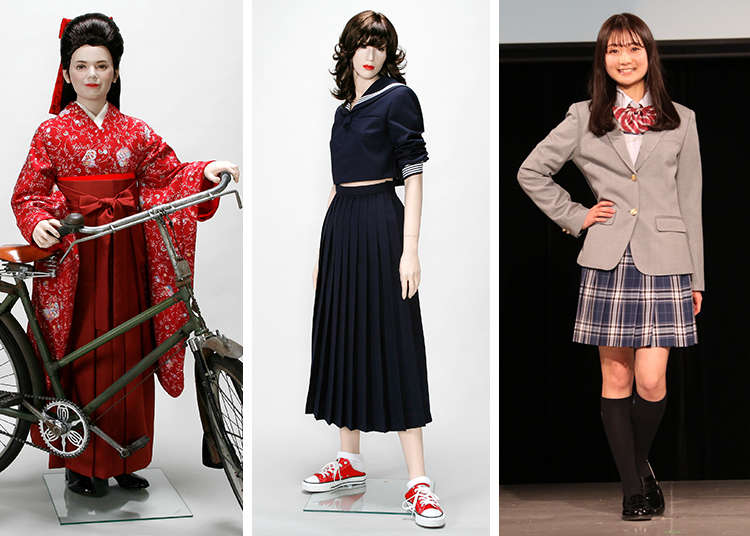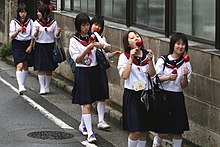Japanese Uniforms Can Be Fun For Everyone
Table of Contents10 Easy Facts About Japanese Uniforms ShownLittle Known Questions About Japanese Uniforms.The Facts About Japanese Uniforms RevealedA Biased View of Japanese UniformsGetting The Japanese Uniforms To Work
Throughout completion of the Meiji period as well as throughout the Taisho period, western style college attires were introduced because they were extra functional and useful than the typical garments. It was primarily the male students that remained in uniform at the start. Relying on the school, females at the time either wore a fit top with skirt, kimono or seafarer attire.Sailor attire was introduced in Taisho 9 (1920's). Japanese uniforms. Find out more concerning the Taisho duration at.
Business people as well as females use dark fits and also white t-shirts while sales staffs in outlet store use the store's attire. Whether they are working in construction, road work, bundle distribution, or the article office, a lot of workers wear a certain attire. By putting on uniforms to match their jobs, workers really feel pride in what they do and also are loaded with motivation as well as energy.
Attires also give the consumer a feeling of security and self-confidence in the product or service. In addition to wearing obligatory attires, Japanese individuals additionally like to wear standard clothes which in itself can be labelled an uniform. They do this either to suit or to provide themselves the best opportunity at success.
The 5-Minute Rule for Japanese Uniforms
 Without thinking about a choice, young Japanese will head to these stores in order to have the utmost possibility of being offered a task. This kind of shop is huge organization in Japan. In Japan, you will frequently see buddies, lovers or households all clothing alike. There is convenience in "similarity".
Without thinking about a choice, young Japanese will head to these stores in order to have the utmost possibility of being offered a task. This kind of shop is huge organization in Japan. In Japan, you will frequently see buddies, lovers or households all clothing alike. There is convenience in "similarity".A winter season seafarer fuku (sailor outfit) with long sleeves on a mannequin. The Japanese college uniform is modeled in look comparable to that of the European-style naval attires and was first used in Japan in the late 19th century, changing the typical robe. Today, school uniforms prevail in several of the Japanese public as well as personal school systems.
The term is a mix of gaku () meaning "study" or "trainee", and ran (or) indicating the Netherlands or, traditionally in Japan, the West in basic; thus, gakuran translates as "Western style garments for pupil (uniform)". [citation needed] The original model of the existing days Gakuran was first developed in 1886 for the students of Tokyo University.

The sailor attire today is normally linked entirely with junior high schools, since a bulk of secondary schools have transformed to more Western-style plaid skirts or blazers - Japanese uniforms. The attire is gender-specific as well as both choices, male or women, are given to students according to the sex they were assigned at birth.
Japanese Uniforms - Truths
Japanese institution attire is understood for its classy look. A lot of colleges in Japan have their attires, and also the style differs relying on helpful resources the school. Japanese uniforms. For Japanese students, college uniform is not only for revealing which institution an individual belongs to. It has turned into one of the fashion items as a result of the change of college consistent designs as well as style fads.
 Currently, you will see just how Japanese school attire has been created as well as altered gradually, and how Japanese trainees appreciate their attires as style. College uniform was to start with introduced in the late 19th century. The very first school uniform called seafarer fuku was inspired by the European naval attires. Japanese took the idea of scaled-down sailor suits of imperial families in Europe, as well as lots of Japanese would certainly see them cute because they might have evoked the Western-style kids's outfits rather than the navy equipment.
Currently, you will see just how Japanese school attire has been created as well as altered gradually, and how Japanese trainees appreciate their attires as style. College uniform was to start with introduced in the late 19th century. The very first school uniform called seafarer fuku was inspired by the European naval attires. Japanese took the idea of scaled-down sailor suits of imperial families in Europe, as well as lots of Japanese would certainly see them cute because they might have evoked the Western-style kids's outfits rather than the navy equipment.Elegant school attires lead to the increase the number of prospects to the college. After 1990s, college uniforms came to be identified not simply as "consistent", yet as "fashion".
The "fashionalization" of Japanese institution uniform caught eyes from throughout the globe, and there are numerous on-line stores where you can get Japanese style college uniforms. Japanese college attire has a large array of kinds. Each college has its attire, usually its institution symbol on. Uniforms secretive institutions often tend to have classy designs while those in public schools often tend to have easy designs.
Everything about Japanese Uniforms
Sailor attire is a preliminary style of Japanese school attire for women trainees, influenced by the marine attire. It consists of a shirt with a sailor-like collar and also pleated skirt.
It is primarily put on by women trainees, as well as it is usual to add bows or connections when using the blazer. In winter season, they wear knit sweatshirt or vest under the blazer. Couple of colleges have the bolero uniform today. It is usually worn with the jumper skirt. Eton jacket is a coat without a collar, and is frequently presented to grade school or junior high.
Jumper skirt used to be the imp source main stream of institution uniform in the summer season, but it is replaced with the various other design when the institution changes the attire. In wintertime, jumper skirt is used under the sports jacket or the bolero. Supporter skirt institution uniform is generally used in elementary institution, in some cases in kindergarten.
It is used with a shirt in the wintertime. Today college attire is put on not just to show which school an my company individual goes to, yet to use as style things as a way of expressing the person's character. Some institutions need pupils to purchase just sports jackets and also school pins assigned by the college to ensure that students can choose the other items such as socks, footwear, bows, bags, and so on.
The smart Trick of Japanese Uniforms That Nobody is Talking About
Sometimes they don't wear their institution attires, yet wear attires that they got in various stores. Garments brand names such as East child as well as Conomi provide a broad variety of optional products for college attires.